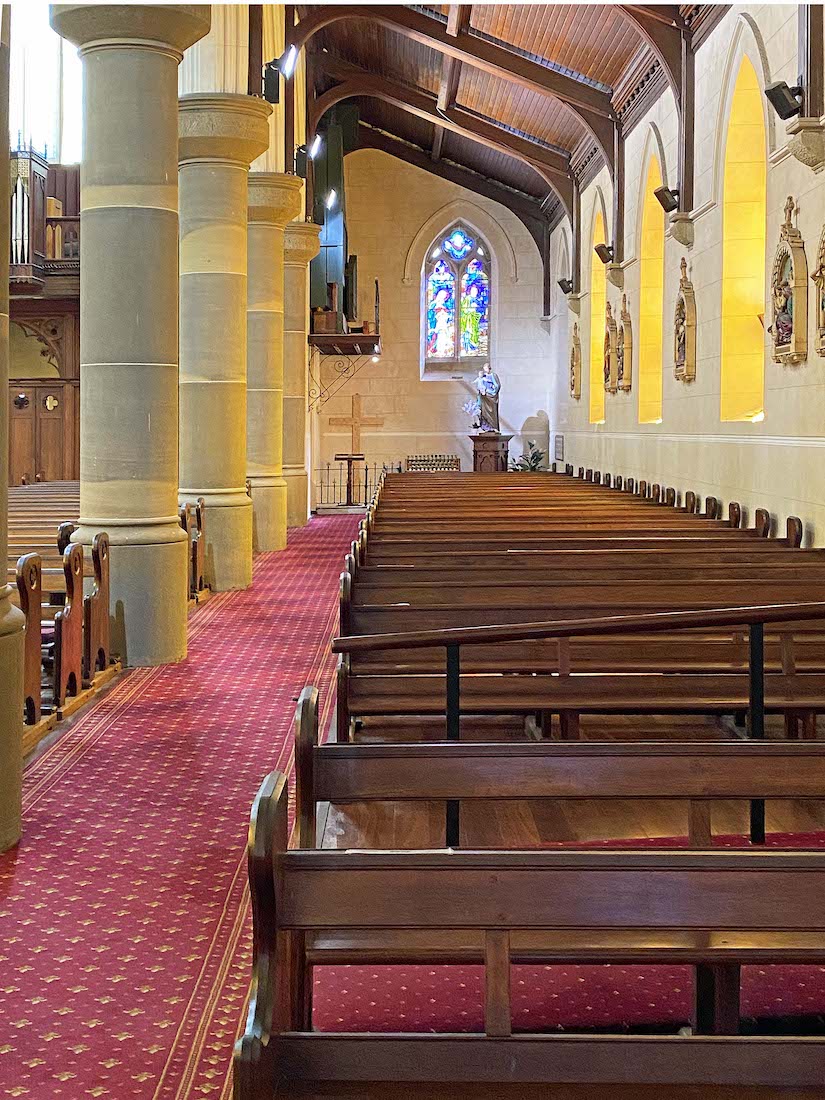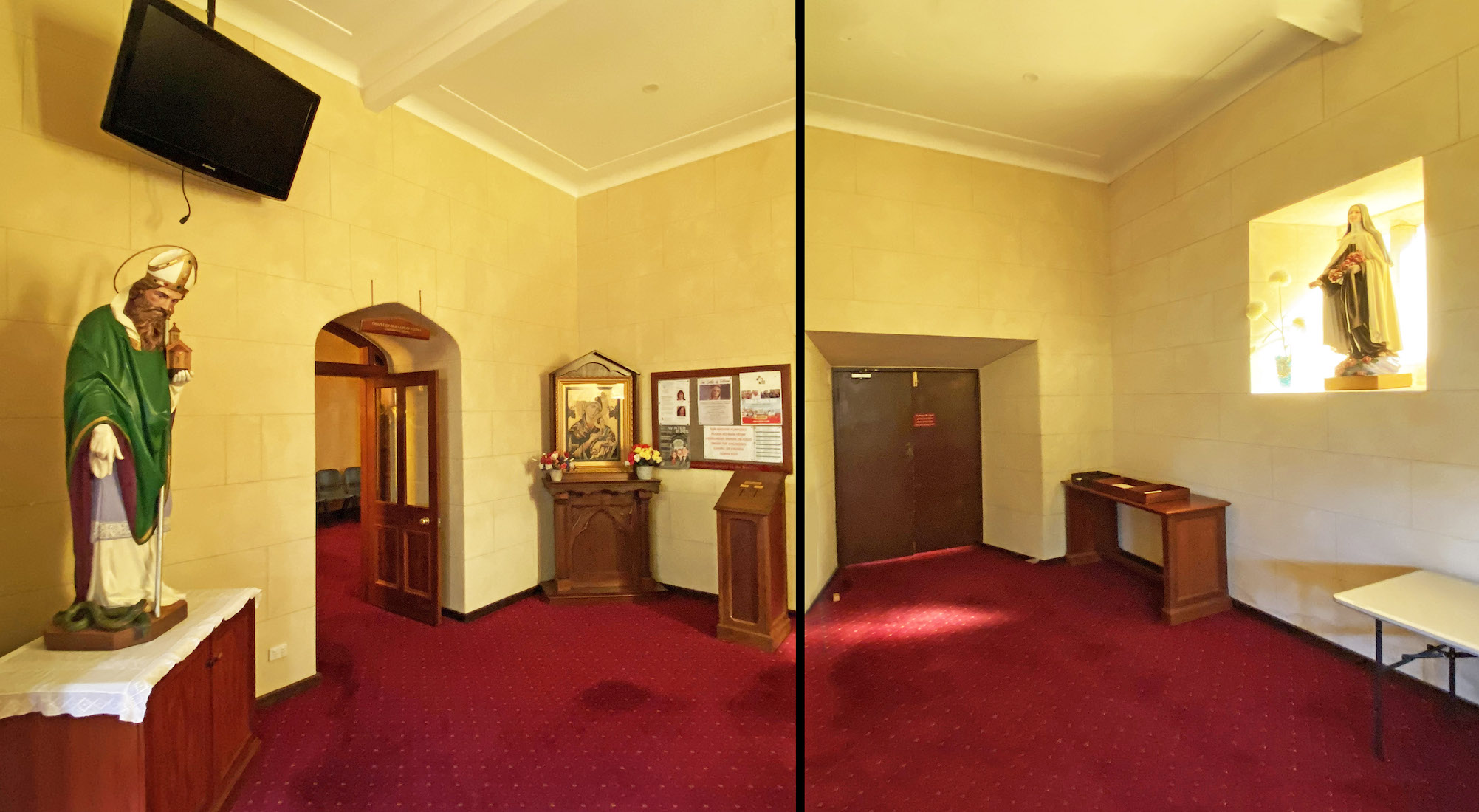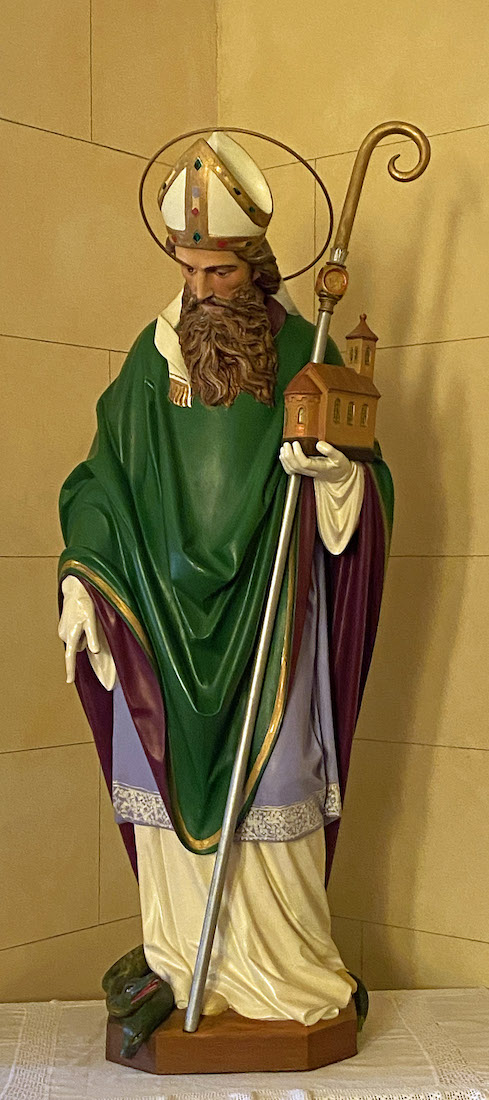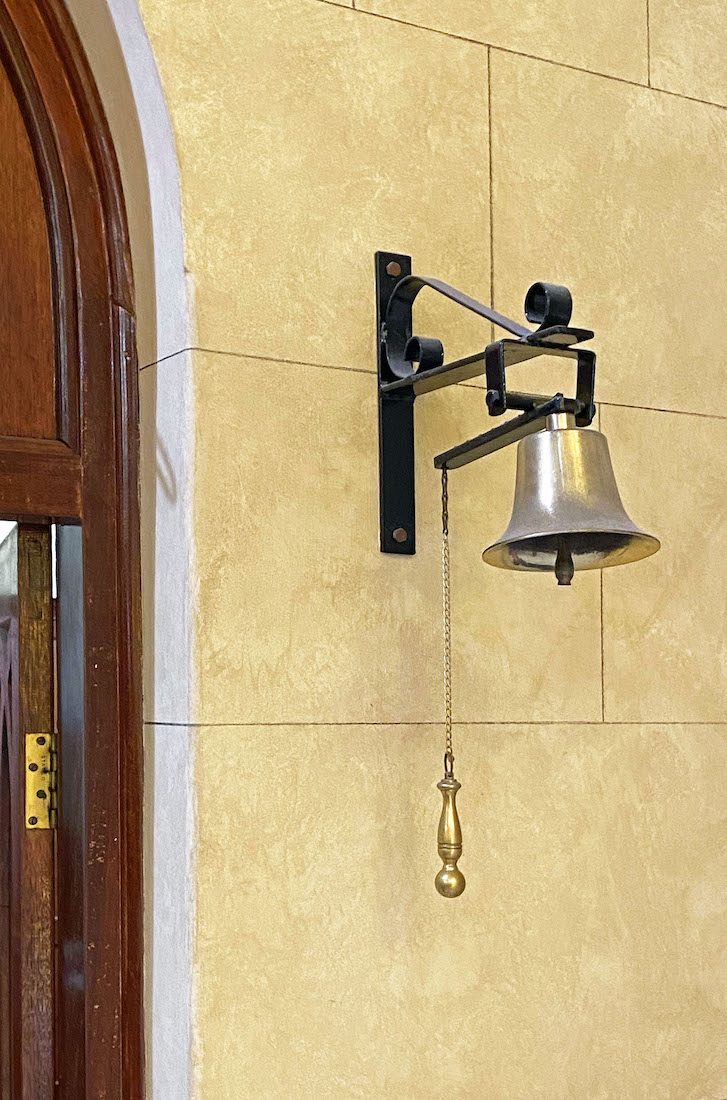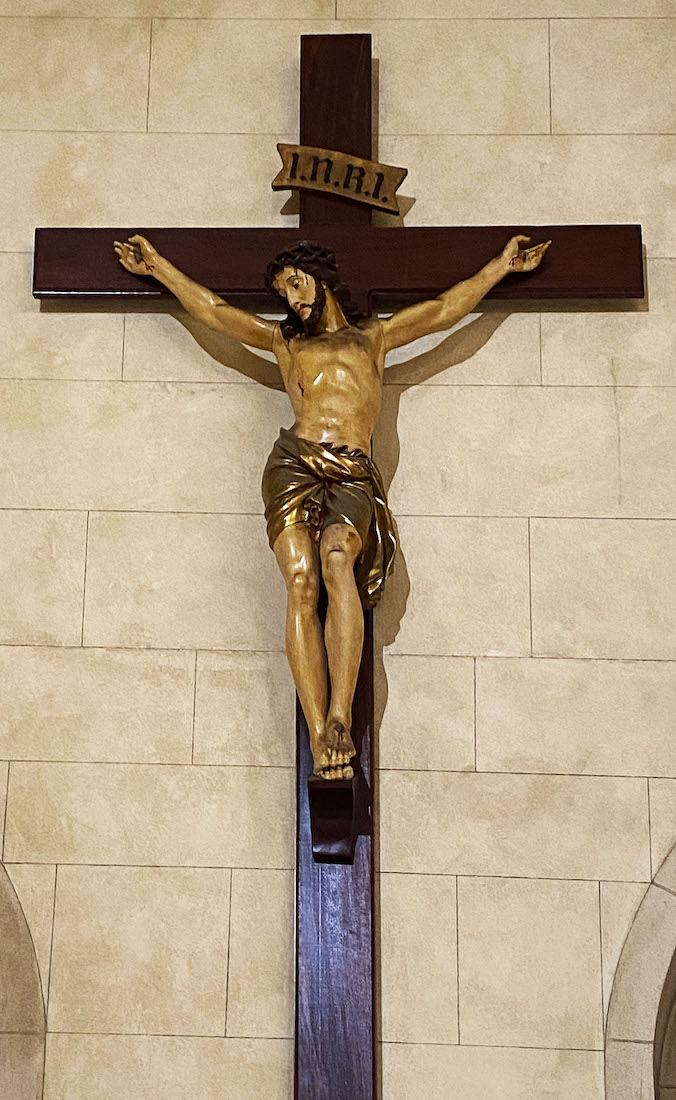
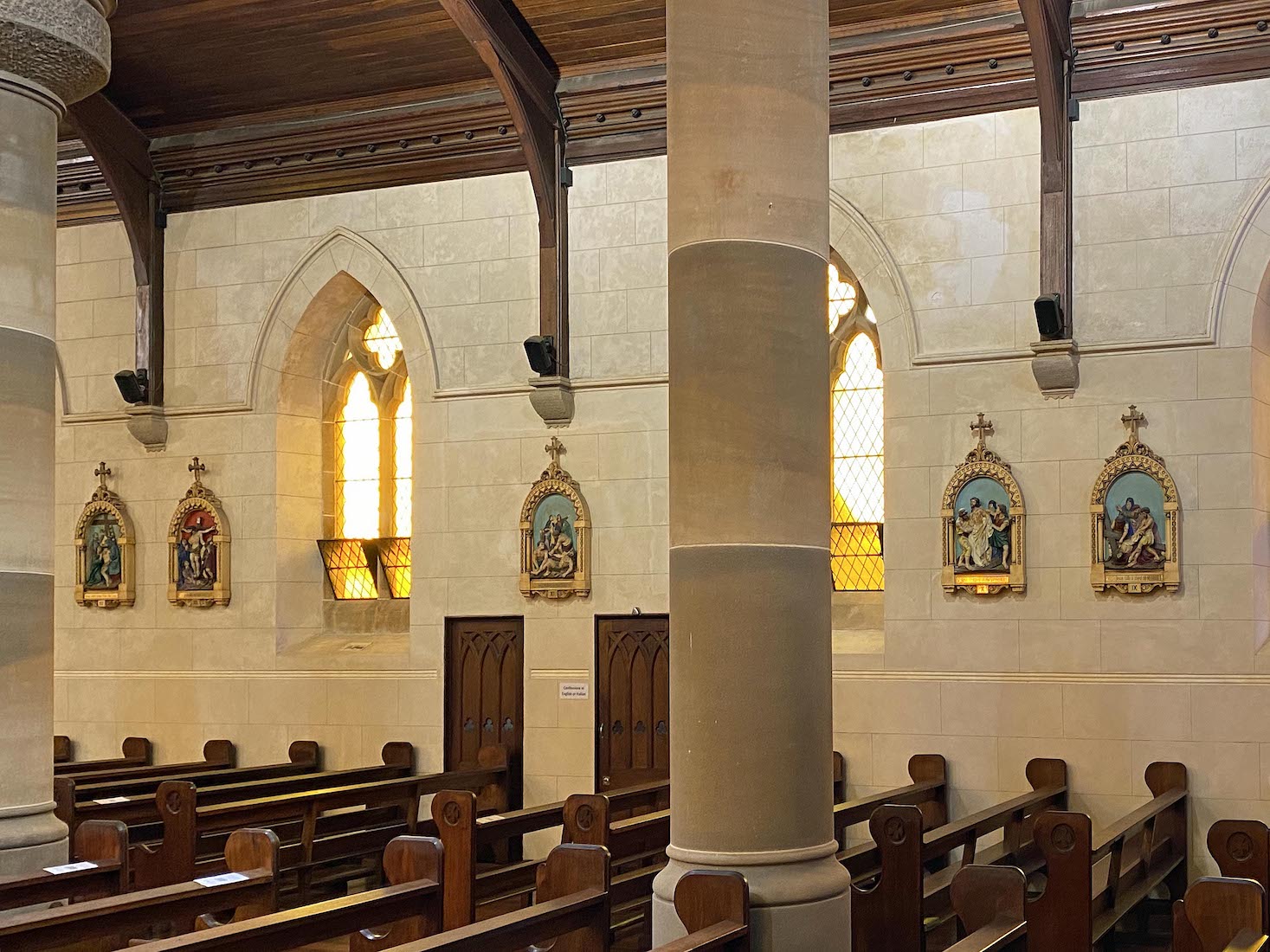
The nave side walls are largely unadorned apart from the stations of the cross which alternate with the amber windows. On the South side, three pairs of doors lead to unseen confessionals INDEX
22. STATION OF THE CROSS AND ST EUGENE DE MAZENOD


At the East end of the North nave wall is a dramatic sculpture: the figure of St Eugène de Mazenod. ••• Eugène de Mazenod, OMI was a French aristocrat and Catholic priest who founded the congregation of the Missionary Oblates of Mary Immaculate. ••• At left we see the first of the 14 stations of the cross which line the walls of the nave. This is a well-designed colourful set, with number and explanatory text below. The complete set can be seen here.
23. SOUTH NAVE AND CLERESTORY
An over-view before we temporarily leave the nave ... . ••• At left is a view along the South nave aisle, looking back to the West end. We notice the confessional doors in the left wall. •••At right, we look across the nave to the North side, taking in the amber clerestory windows, and the wonderful timber ceiling.
24. NORTH NAVE
On the other side of the nave, two views up and down the North aisle. In particular, we notice the walk-way and rail near the East end, leading to a door in the side wall between the first station of the cross, and St Eugene de Mazenod. We leave the nave and go through that doorway now.
25. NORTH FOYER
This is the North foyer. We have come through the double door which has closed behind us. There are several items of interest here: St Patrick on our left, Our Lady of Perpetual Succour in the corner, and St Thérèse of Lisieux in the window opening. The exit from this foyer is behind us; the doorway at left leads through to a chapel which we will explore shortly.
26. ST PATRICK, LADY OF SORROWS, ST THÉRÈSE
St Patrick is the patron saint of Ireland and of this Basilica. He is almost always pictured with a snake underfoot – being credited with the fact that there are no snakes in Ireland. ••• Our Mother of Perpetual Succour (colloquially known as Our Lady of Perpetual Help) is a Roman Catholic title of the Blessed Virgin Mary associated with a 15th-century Byzantine icon – a copy seen here. ••• Thérèse of Lisieux OCD, born Marie Françoise-Thérèse Martin (1873 – 1897), was a French Catholic Discalced Carmelite nun who is widely venerated in modern times. She is popularly known in English as the Little Flower of Jesus, or simply the Little Flower.
27. OUR LADY OF FATIMA
Moving through to the adjacent chapel, we find a shrine to Our Lady of Fátima. Our Lady of Fátima is a Catholic title of Mary, mother of Jesus, based on the Marian apparitions reported in 1917 by three shepherd children at the Cova da Iria in Fátima, Portugal. The three children were Lúcia dos Santos and her cousins Francisco and Jacinta Marto. The children described her as ‘a Lady more brilliant than the Sun’.
28. NORTHEAST SACRISTY
The sacristies are places for the priests to prepare for services, and are not generally open to the public. It happened that I came through here to the Basilica, and was amazed at this enormous dresser. The door through to the Church is at right, and opens into the so-called North transept.
29. SACRISTY BELL, NORTH TRANSEPT
We are standing before the North transept which serves as the baptistry. The sacristy bell is at left, next to an Australian flag, and the baptismal font has central place. On the wall behind is a central crucifix, a cupboard of holy oils, and two stained glass windows.
30. NORTH TRANSEPT AND FONT
Baptism is regarded as the rite of entry into the Church and into a relationship with Christ. The octagonal font carries various Christian symbols.
31. NORTH TRANSEPT WINDOWS
The two stained glass windows have simple themes. At left we see the baptism of Jesus by John the Baptist in the River Jordan. The window at right shows the Day of Pentecost when tongues of fire descended on the gathered disciples. At the top of the window is the hand of God and the dove of the Holy Spirit.
32. OILS AND CRUCIFIX
Shown at right is a large crucifix. I am interested that almost without exception, a crucifix has Jesus looking to his right. ••• At left is shown the cupboard containing the three holy oils. These are the oil of the sick (pure olive oil used for anointing the sick), the oil of the catechumens (pure olive oil used for anointing adults and infants prior to baptism), and the holy chrism oil (olive oil mixed with balsam, used to consecrate someone for special service).
33. ORGAN PIPES ON THE SOUTH SIDE
This is a view across the Church to the Lady Chapel on the South side. When the Basilica organ was rebuilt again in 1988–90, a second interconnected two-manual organ was added in the South transept. The organs were given in thanksgiving in memory of the many priests of the Congregation of Oblates of Mary Immaculate who have served the parish since their arrival from Ireland in 1894.
34. ORGAN CONSOLE
The second organ console has two sets of pipes above.
36. SOUTH TRANSEPT WINDOWS
This transept has a pair of stained glass windows of Christ: the Risen Christ, and the Glorified Christ.
37. SACRED HEART
Between the windows is a statue of the Sacred Heart. The Most Sacred Heart of Jesus is one of the most widely practised and well-known Catholic devotions, wherein the heart of Jesus Christ is viewed as a symbol of ‘God’s boundless and passionate love for mankind’.
38. DIVINE MERCY
To the right is this well known image of Christ. In 1931, Christ appeared to artist St. Faustina in a vision. She saw Jesus clothed in a white garment with His right hand raised in blessing. His left hand was touching His garment in the area of the Heart, from where two large rays came forth, one red and the other pale. She gazed intently at the Lord in silence, her soul filled with awe, but also with great joy. Jesus said to her: ‘Paint an image according to the pattern you see, with the signature: Jesus, I trust in You.’ The image represents the graces of Divine Mercy poured out upon the world, especially through Baptism and the Eucharist.
40. OUR LADY OF CAPO D’ORLANDO
At left is a wooden stand on which there is a pedestal with a silver canopied Madonna and Child. This is the statue of Our Lady of Capo d’Orlando. Capo d’Orlando is a town on the north coast of Sicily. A mysterious pilgrim appeared at the sanctuary dedicated to the Madonna above the town, and left a small image of the Madonna and Child which turned out to have miraculous powers.




